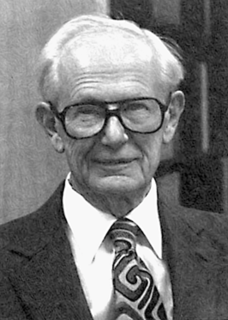 W
WComfort Avery Adams was an American electrical engineer who as a student helped Albert A. Michelson with the Michelson–Morley experiment (1887), which was later viewed as confirming the special relativity theory of Albert Einstein (1905). He was a recipient of the IEEE Edison Medal and AIEE Lamme Medal.
 W
WHarold Stephen Black was an American electrical engineer, who revolutionized the field of applied electronics by discovering the negative feedback amplifier in 1927. To some, his discovery is considered the most important breakthrough of the twentieth century in the field of electronics, since it has a wide area of application. This is because all electronic devices are inherently nonlinear, but they can be made substantially linear with the application of negative feedback. Negative feedback works by sacrificing gain for higher linearity. By sacrificing gain, it also has an additional effect of increasing the bandwidth of the amplifier. However, a negative feedback amplifier can be unstable such that it may oscillate. Once the stability problem is solved, the negative feedback amplifier is extremely useful in the field of electronics. Black published a famous paper, Stabilized feedback amplifiers, in 1934.
 W
WVannevar Bush was an American engineer, inventor and science administrator, who during World War II headed the U.S. Office of Scientific Research and Development (OSRD), through which almost all wartime military R&D was carried out, including important developments in radar and the initiation and early administration of the Manhattan Project. He emphasized the importance of scientific research to national security and economic well-being, and was chiefly responsible for the movement that led to the creation of the National Science Foundation.
 W
WNathan Cohn was an American electrical engineer best known for his work in the development of automatic control techniques for interconnected electric power systems. He worked for the Leeds & Northrup Company for 48 years.
 W
WFrank Conrad was an electrical engineer, best known for radio development, including his work as a pioneer broadcaster. He worked for the Westinghouse Electrical and Manufacturing Company in East Pittsburgh, Pennsylvania for half a century. His experimental radio station provided the inspiration, and he acted in an advisory role, for the establishment of Westinghouse's first broadcasting service, over radio station KDKA.
 W
WYu Hsiu Ku or Gu Yuxiu was a Chinese academic and polymath. He was one of the first Chinese people to earn a doctorate from the Massachusetts Institute of Technology, in 1928, and became a leader in higher education in China until the fall of the Republic of China in 1949. Afterwards, he worked for many years as a professor of electrical engineering at the University of Pennsylvania.
 W
WWarren Perry Mason was an American electrical engineer and physicist at Bell Labs. A graduate of Columbia University, he had a prolific output, publishing four books and nearly a hundred papers. He was issued over two hundred patents, more than anyone else at Bell Labs. His work included acoustics, filters, crystals and ceramics, materials science, polymer chemistry, ultrasonics, bonding to semiconductors, internal friction, and viscoelasticity.
 W
WJoseph Slepian (February 11, 1891 – December 19, 1969) was an American electrical engineer known for his contributions to the developments of electrical apparatus and theory.
 W
WLewis Buckley Stillwell was an American electrical engineer and the president of American Institute of Electrical Engineers (AIEE) from 1909 to 1910. He received the AIEE Lamme Medal (1933) and the AIEE Edison Medal (1935), for "his distinguished engineering achievements and his pioneer work in the generation, distribution, and utilization of electric energy." He also was inducted into the IEEE's Electrical Engineering Hall of Fame. His papers (1886-1939) are held in the Manuscript Division of the Princeton University Library. He was elected as a member of the National Academy of Sciences in 1921.
 W
WJohn George Trump was an American electrical engineer, inventor, and physicist. A professor at the Massachusetts Institute of Technology from 1936 to 1973, he was a recipient of the National Medal of Science and a member of the National Academy of Engineering. John Trump was noted for developing rotational radiation therapy. Together with Robert J. Van de Graaff, he developed one of the first million-volt X-ray generators. He was the paternal uncle of President Donald Trump.
 W
WHenry Ellis Warren was an American inventor credited with invention of the first synchronous electric clock which kept time from the oscillations of the power grid in 1918 as well as with 134 other inventions. Warren founded Warren Telechron Company in 1912 which later was acquired by General Electric in 1943. Warren was noted as the "father of electric time". Telechron went out of business in 1992. Just between 1916 and 1926 the company sold 20 million clocks. The clocks remained popular into the 1950s. In 1940 he also invented the "singing clock" which instead of a pendulum had a vibrating metal string.
 W
WVladimir Kosmich Zworykin was a Russian-American inventor, engineer, and pioneer of television technology. Zworykin invented a television transmitting and receiving system employing cathode ray tubes. He played a role in the practical development of television from the early thirties, including charge storage-type tubes, infrared image tubes and the electron microscope.